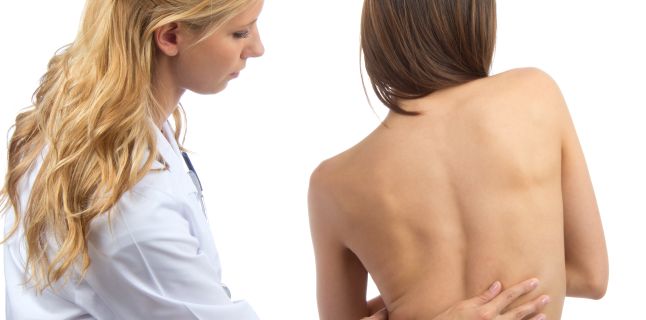Causes of scoliosis

There are several types of scoliosis: - it is caused by an abnormality of bones present at birth. Neuromuscular scoliosis - is a result of abnormal muscles and nerves. It is usually present in people with or cerebral palsy. - is the most common type of scoliosis, this type does not have a specific cause. Girls are more affected by scoliosis. Often, the disease occurs in puberty, over 90% of cases (ideopathic scoliosis).
The remaining 10% have causes such as: congenital, muscular dystrophy, Marfan's disease,. The clinical examination is appropriate to take place from the birth of a child precisely in order to detect, for example, certain congenital forms with vertebral deformities. The child will then be examined by the pediatrician at the beginning of the kindergarten or school. Also, it is extremely important to examine the child by parents who can easily detect any deformity that occurs in the spine and the chest. The first signs that a child has scoliosis are unequal shoulders, uneven waist or inclination to one side of the body.
If scoliosis is suspected, it is recommended to perform a confirmation. With this, the doctor will be able to assess the severity of the scoliosis and possible risks that may worsen. After these investigations, your doctor will recommend the most appropriate treatment. • Most teenagers who have a type of scoliosis that is not very serious can get an indication of using a. This is the standard treatment for adolescents who have a spinal curvature between 25 and 40 degrees, with the aim of temporarily correcting.
• Patients who have a spine curve of 50 degrees or more may be undergoing surgery. The operation for scoliosis involves vertebral joining, a process called spinal fusion. • it is very important for strengthening the muscles and can really help patients with scoliosis. At the same time swimming and especially hydrokinetotherapy are very often used in the recovery of scoliosis. Exercises in the pool are effective for any age and any type of scoliosis.
Source : sfatulmedicului.ro
Views : 2981
Popular Article
- (photo) Nude becomes art.
Posted: 2018-03-17, 9592 views.
- The harmful effects of air conditioning on the skin
Posted: 2017-06-08, 8274 views.
- 3 causes of dyed hair discoloration
Posted: 2017-06-15, 8146 views.
- Why early puberty occurs in girls: symptoms, favors, diagnosis and treatment
Posted: 2017-10-24, 8003 views.
- Good or bad skin treatments in the hot season
Posted: 2017-06-07, 7740 views.
Recommendations
- (photo) Nude becomes art.
Posted: 2018-03-17, 9592 views.
- The harmful effects of air conditioning on the skin
Posted: 2017-06-08, 8274 views.
- 3 causes of dyed hair discoloration
Posted: 2017-06-15, 8146 views.
- Good or bad skin treatments in the hot season
Posted: 2017-06-07, 7740 views.
- Risks of practicing sports on hot days
Posted: 2017-06-12, 7337 views.
 4 effective ingredients in the fight against acne.
4 effective ingredients in the fight against acne. How to get rid of hiccups fast
How to get rid of hiccups fast The wheat bran diet: the secret of lost pounds as if by magic
The wheat bran diet: the secret of lost pounds as if by magic The recipe that will sweeten your soul this weekend!
The recipe that will sweeten your soul this weekend!  Is it dangerous or not to refreeze meat after thawing it?
Is it dangerous or not to refreeze meat after thawing it?  The unusual sign of diabetes indicated by saliva.
The unusual sign of diabetes indicated by saliva. What to drink to boost your immune system.
What to drink to boost your immune system. 10 foods that help you never age.
10 foods that help you never age. What actually happens in your body if you drink a cup of coffee for breakfast
What actually happens in your body if you drink a cup of coffee for breakfast 5 surprising benefits of chia seeds
5 surprising benefits of chia seeds